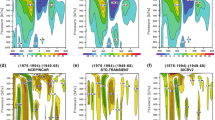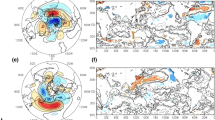Abstract
The ability of five, global coupled climate models to simulate important atmospheric circulation characteristics in the Southern Hemisphere for the period 1960–1999 is assessed. The circulation features examined are the Southern Hemisphere annular mode (SAM), the semi-annual oscillation (SAO) and the quasi-stationary zonal wave 3 (ZW3). The models assessed are the National Center for Atmospheric Research Community Climate System Model Version 3 (CCSM3), the Commonwealth Scientific and Industrial Research Organisation Mark 3, the Geophysical Fluid Dynamics Laboratory Model, the Goddard Institute for Space Studies Model ER (GISS-ER) and the UK Meteorological Office Hadley Center Coupled Model Version 3. The simulations were compared to the NCAR–NCEP reanalyses. The models simulate a SAO which differs spatially from the observed over the Pacific and Indian oceans. The amplitudes are too high over the southern ocean and too low over the midlatitudes. These differences are attributed to a circumpolar trough which is too deep and extends too far north, and to the inability of the models to simulate the middle to high latitude temperature gradient. The SAM is well-represented spatially by most models but there are important differences which may influence the flow over the Pacific and in the region extending from the Ross to Weddell Seas. The observed trend towards positive polarity in the SAM is apparent in the ensemble averages of the GISS-ER and CCSM3 simulations, suggesting that the trend is due to external forcing by changes in the concentration of ozone and greenhouse gases. ZW3 is well-represented by the models but the observed trend towards positive phases of ZW3 is not apparent in the simulations suggesting that the observed trend may be due to natural variability, not external forcing.









Similar content being viewed by others
References
Cai W, Whetton PH, Karoly DJ (2003) The response of the Antarctic Oscillation to increasing and stabilized atmospheric CO2. J Clim 16:1525–1538
Fyfe JC, Boer GJ, Flato GM (1999) The Arctic and Antarctic oscillations and their projected changes under global warming. Geophys Res Lett 26:1601–1604
Gong D, Wang S (1999) Definition of the Antarctic oscillation index. Geophys Res Lett 26:459–462
Gordon HB, Rotstayn LD, McGregor MR, Dix MR, Kowalczyk EA, O’Farrell SP, Waterman LJ, Hirst AC, Wilson SG, Collier MA, Watterson IG, Elliot TI (2002) The CSIRO Mk3 Climate System Model. CSIRO Atmospheric Research Technical Paper no. 60, 134 pp
Gordon C, Cooper C, Senior CA, Banks H, Gregory JM, Johns TC, Mitchell JFB, Wood RA (2000) The simulation of SST, sea ice extents and ocean heat transports in a version of the Hadley Centre coupled model without flux adjustments. Clim Dyn 16:147–168
Hines KM, Bromwich DM, Marshall GJ (2000) Artificial surface pressure trends in the NCAR–NCEP reanalysis over the Southern Ocean and Antarctica. J Clim 13:3940–3952
Holland MM, Raphael MN (2005) Twentieth century simulation of the Southern Hemisphere climate in coupled models. Part II: sea ice conditions and variability (this issue)
Hurrell JW, van Loon H (1994) A modulation of the atnospheric annual cycle in the Southern Hemisphere. Tellus 46A:325–338
K-1 model developers (2004) K-1 coupled model (MIROC) description, K-1 technical report, 1. In: Hasumi H, Emori S (eds) Center for Climate System Research, University of Tokyo, p 34
Kalnay E et al (1996) The NCEP/NCAR 40-Year Reanalysis project. Bull Am Met Soc 77:437–472
Karoly DJ (1989) Southern Hemisphere circulation features associated with El Nino-Southern oscillation events. J Clim 2:1239–1251
Kidson JW (1988) Interannual variations in the Southern Hemisphere circulation. J Clim 1:1177–1198
Kidson JW (1999) Principal modes of Southern Hemisphere low-frequency variability obtained from NCEP/NCAR reanalyses. J Clim 12:2808–2830
Kiehl JT, Boville BA, Briegleb BP (1988) Response of a general circulation model to a prescribed Antarctic ozone hole. Nature 332:501–504
Large WG, van Loon H (1989) Large scale, low frequency variability of the 1979 FGGE surface buoy drifts and winds over the Southern Hemisphere. J Phys Oceanogr 19:216–232
Lefebvre W, Goosse H (2005) Influence of the Southern Annular Mode on the sea ice-ocean system: the role of the thermal and mechanical forcing. Ocean Science Discuss 2:299–329
Liu J, Curry JA, Martinson DG (2004) Interpretation of recent Antarctic sea ice variability. Geophys Res Lett 31 doi:10.1029/2003GL018732
van Loon H (1967) The half-yearly oscillations in middle and high Southern latitudes and the coreless winter. J Atmos Sci 24:472–486
van Loon H, Rogers JC (1984) Interannual variations in the half-yearly cycle of pressure gradients and zonal winds at sea level on the Southern Hemisphere. Tellus 36A:76–96
Marshall GJ (2003) Trends in the Southern annular mode from observations and reanalyses. J Clim 16:4134–4143
Meehl GA (1991) A re-examination of the mechanism of the semi-annual oscillation in the Southern Hemisphere. J Clim 4:911–926
Meehl GA, Hurrell JH, van Loon H (1998) A modulation of the mechanism of the semi-annual oscillation in the Southern Hemisphere. Tellus 50A:442–450
Mo KC, White GH (1985) Teleconnections in the Southern Hemisphere. Mon Wea Rev 113:22–37
Raphael MN (2004) A zonal wave 3 index for the Southern Hemisphere. Geophys Res Lett 31, doi:10.1029/2004GL020365
Schmidt GA et al (2005) Present-day atmospheric simulations using GISS ModelE: comparison to in situ, satellite and reanalysis data. J Clim (accepted for publication)
Simmonds I, Walland DJ (1998) Decadal and centennial variability of the southern semiannual oscillation simulated in the GFDL coupled GCM. Clim Dyn 14:45–53
Thompson DWJ, Solomon S (2002) Interpretation of recent Southern Hemisphere climate change. Science 296:895–899
Thompson DWJ, Wallace JM (2000) Annular modes in the extratropical circulation, I: month to month variability. J Clim 5:1000–1016
Trenberth KE (1980) Planetary waves at 500 mb in the Southern Hemisphere. Mon Wea Rev 108:1378–1389
Trenberth KE, Mo KC (1985) Blocking in the Southern Hemisphere. Mon Wea Rev 133:38–53
Trenberth KE, Large WG, Olson JG (1990) The mean annual cycle in global ocean wind stress. J Phys Oceanogr 20:1742–1760
Van Loon H (1991) A review of the surface climate of the Southern Hemisphere and some comparisons with the Northern Hemisphere. J Mar Syst 2:171–1994
Van Loon H, Jenne RL (1972) The zonal harmonic standing waves in the Southern Hemisphere. J Geophys Res 77:992–1003
Xu J-S, von Storch H, van Loon H (1990) The performance of four spectral GCMs in the Southern Hemisphere: the January and July climatology and the semiannual wave. J Clim 3:53–70
Acknowledgements
This research was funded by NSF and DOE as a Climate Model Evaluation Project (CMEP) grant# NSF ATM 0444682, under the US CLIVAR Program (http://www.usclivar.org/index.html). We acknowledge the international modeling groups for providing their data for analysis, the Program for Climate Model Diagnosis and Intercomparison (PCMDI) for collecting and archiving the model data, the JSC/CLIVAR Working Group on Coupled Modelling (WGCM) and their Coupled Model Intercomparison Project (CMIP) and Climate Simulation Panel for organizing the model data analysis activity, and the IPCC WG1 TSU for technical support. The IPCC Data Archive at Lawrence Livermore National Laboratory is supported by the Office of Science, US Department of Energy. This research uses data provided by the Community Climate System Model project (http://www.ccsm.ucar.edu), supported by the Directorate for Geosciences of the National Science Foundation and the Office of Biological and Environmental Research of the US Department of Energy. We thank two anonymous reviewers for their useful comments which served to improve this manuscript. We also thank Chase Langford for his assistance with the Figures.
Author information
Authors and Affiliations
Corresponding author
Rights and permissions
About this article
Cite this article
Raphael, M.N., Holland, M.M. Twentieth century simulation of the southern hemisphere climate in coupled models. Part 1: large scale circulation variability. Clim Dyn 26, 217–228 (2006). https://doi.org/10.1007/s00382-005-0082-8
Received:
Accepted:
Published:
Issue Date:
DOI: https://doi.org/10.1007/s00382-005-0082-8




